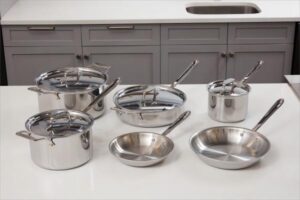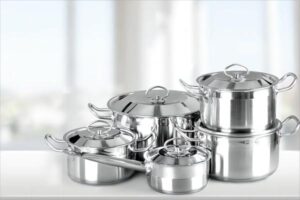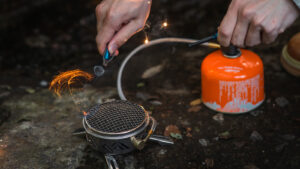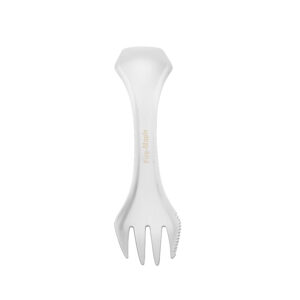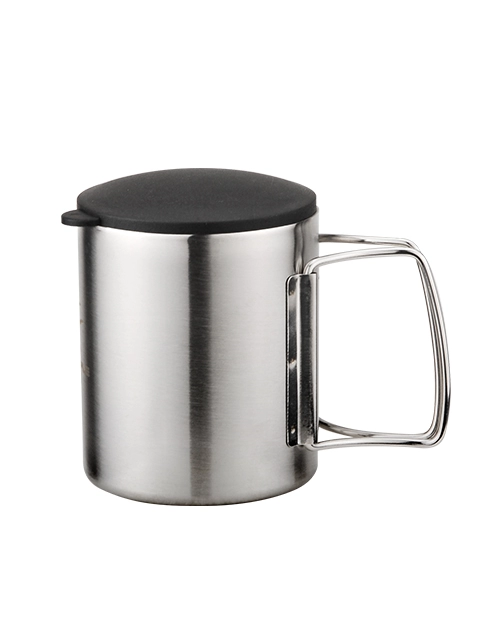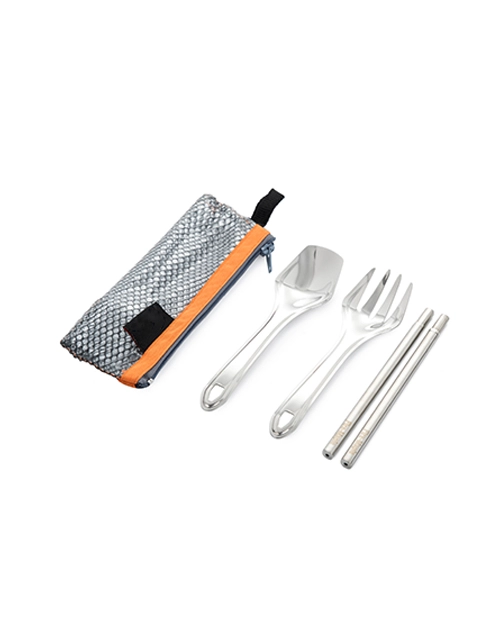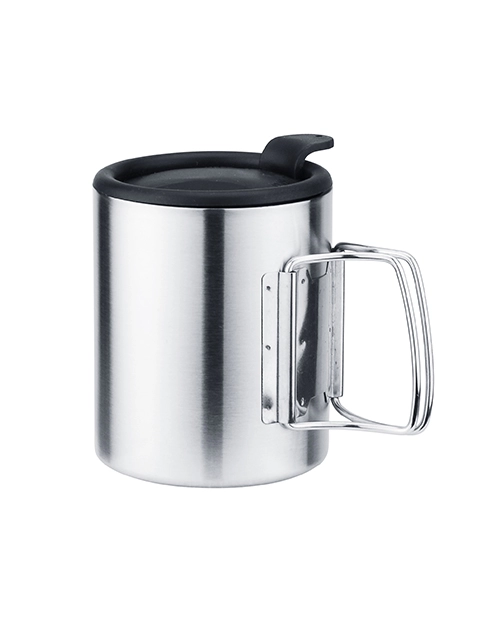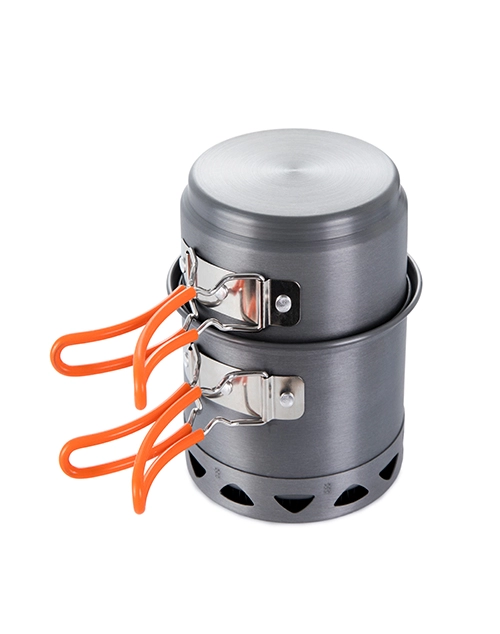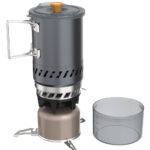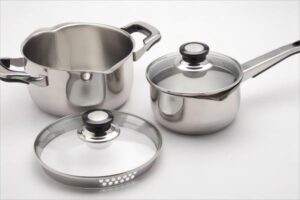
Can metal be used on stainless steel cookware?
Yes. Yes, it can. Safely. Usually. This article will dig into more specifics about when steel on steel isn’t a great idea.
Can You Use Metal on Stainless Steel Cookware?
Metal utensils are okay to use on stainless steel cookware as long as it does not have a nonstick coating. Regular stainless-steel cookware is robust, with a coating of strong, bright nickel on top. It can withstand repeated use of metal utensils without causing harm to your pots and pans’ surfaces.
A steel scrubbing brush is the one metal item you should avoid using on a natural stainless-steel pan. These have the potential to scratch the steel.
If your stainless-steel pans have a ceramic or nonstick coating, however, you must use bamboo, nylon, or silicone utensils on the pan. Check out our guide to the best stainless-steel cutlery.
Types of Stainless-Steel Cookware
Stainless steel cookware is made of an alloy of iron, chromium, and nickel, which together provide a very durable surface. It is lightweight, holds heat effectively, and can be used on all cooktops, even induction. All of these qualities combine to make this material ideal for nontoxic cookware that lasts forever.
100% Pure Stainless-Steel Cookware
There is no such thing as 100% pure stainless-steel cookware exist. Stainless steel is a metal alloy composed of many metals, with variable metal ratios in different grades of steel. Steel is commonly blended or coated with aluminum or copper in cookware since it does not transfer heat efficiently (but it does hold heat well!).
Clad Stainless Steel
When deciding which material is ideal for cookware, aluminum, and stainless-steel cookware are frequently pitted against one another. There are obviously notable distinctions between aluminum and stainless-steel cookware, the strongest pans are those that combine the force of aluminum and stainless steel in a multilayer design.
These pans have three or five-ply designs that sandwich stainless steel and aluminum layers together to provide a better cooking utensil. These pans are made of “clad” stainless steel and may be used with metal utensils. There may be some little scratching, but it will not significantly reduce the pan’s life.
Nonstick Stainless Steel
Nonstick Stainless-Steel cookware has all of the features stated above, including an extra nonstick coating that facilitates food release. Unfortunately, this covering prevents these pans from being used with metal cutlery.
Nonstick coatings are classified into three types: PTFE-based, PTFE-free ceramic, and natural seasoning.
PTFE Nonstick Cookware
PTFE (polytetrafluoroethylene) is a synthetic polymer that produces a highly effective nonstick surface. Teflon is the market leader in PTFE-based nonstick, yet nonstick coatings can be PTFE without the Teflon brand name. Because of the possible health concerns of overheating, many people are turning away from this sort of nonstick coating these days.
When purchasing stainless steel, it is important to first check the box to find out whether the nonstick is PTFE-free. (Keep in mind that PFOA-free does not imply PTFE-free!) Unfortunately, the majority of nonstick stainless steel on the market is PTFE-based. As a result, we prefer to purchase ordinary uncoated stainless-steel cookware since we are more convinced that it is non-toxic.
PTFE Ceramic Cookware
Cookware without PTFE mostly use a ceramic coating created by heating a sand-based silicone gel to 800 °F, give or take. Some producers incorporate mineral, titanium, or even diamond particles into the silicone. Some people apply an extra coating or glaze to the surface.
Seasoned with a Natural Patina
Everyone is aware that cast iron and carbon steel may be seasoned by baking layers of oil onto the metal to create a shiny hydrophobic surface. You may do the same with stainless steel pans, but they will no longer be shiny and clean.
So, which coated stainless steel pans are safe to use with metal utensils?
Sadly, none of them.
Whisks, spatulas, and spoons made of steel or metal will scrape, chip, scratch, or damage PTFE, ceramic, or even natural oil coatings. The good news is that a scratched oil patina can be re-season. The bad news is that scratches in Teflon or ceramic coatings cannot be repaired. These scratches will not only render the nonstick utterly worthless; they may also pose health risks.
Ceramic pans can be reasonably non-toxic depending on the glazes and coatings used. A metal tool chipping the sol-gel layer on porcelain may not be harmful to your health (albeit it will damage your pan.) However, the pan’s metal core will be exposed, potentially leaching aluminum into your meal.
Scratching a PTFE-based nonstick coating, on the other hand, is another story. Scratching a nonstick coating might cause microplastics to be released into your meal. According to research conducted by the Global Centre for Environmental Remediation, the tiniest surface scratch can result in the entry of 9,000 plastic microparticles into your meal! While the health impacts of these microplastics are still being explored, we believe it is safer to avoid this risk entirely.
What if the Manufacturer says You Can Use Metal Utensils on Non-stick Stainless Steel?
Some nonstick cookware is marketed as being safe to use with metal utensils but use at your own risk. Before using metal utensils on your pan, check the manufacturer’s guarantee to determine whether they are prohibited. Steel utensils, according to customers’ experience, tend to scrape and deteriorate with time. As a result, we recommend that you avoid using metal utensils on any nonstick or coated stainless steel cookware.
1. The Differences Between Stainless Steel, Cast Iron, Aluminum, and Copper.
Stainless steel:Durable, non-reactive, and able to withstand high temperatures, it heats evenly and is resistant to rust and corrosion, making it a popular choice for everyday use.
Cast iron: Heavier, but it handles temperature well, making it suitable for slow cooking or foods that need to be kept warm. However, it can react with acidic foods and affect the taste unless the cast iron is enameled.
Aluminum: Lightweight, soft, and a strong conductor of heat, it allows food to heat up quickly.And unlike stainless steel, raw aluminum can react with acidic or alkaline foods, changing the taste of the food and sometimes causing pitting on the surface.
2. How to maintain stainless steel cookware?
Proper care ensures your stainless steel cookware stays in great condition for many years. Here are some key tips:
Cleaning: Always let the pan cool before washing. Clean stainless steel with warm water or dish soap. For more stubborn stains or stuck-on food, you can use a mixture of baking soda and water as a mild abrasive. Avoid using steel wool or rough scouring pads as they can scratch the surface. For discoloration caused by heat, a vinegar soak or stainless steel cleaner can restore the shine.
Storage:Stack cookware carefully to avoid scratching the surface. If stacking is necessary, you can place a soft cloth or paper towel between each piece. Hanging stainless steel pans on a pot rack can also prevent scratches and provide easy access.
Maintenance: Although stainless steel does not require much maintenance, regular polishing with a stainless steel cleaner can help remove discoloration and water spots, keeping your cookware bright and polished.
Copper:Copper cookware is a good conductor of heat, but it can also react with certain foods, so it’s usually made with non-reactive metals like stainless steel. Copper is also high maintenance and requires regular polishing to maintain its appearance, which is not very convenient for the average person.
Overall, stainless steel offers the best combination of durability, ease of maintenance, and non-reactivity, while materials like cast iron and copper are better suited for specific cooking techniques.
3.Buying Guide: Choose the stainless steel cookware that suits you best.
Several factors can help you choose the right stainless steel cookware for your kitchen.
Construction:Look for stainless steel cookware with a multi-layer construction, which means there are layers of aluminum or copper sandwiched between the stainless steel layers. This improves thermal conductivity while still providing the durability of stainless steel. Common choices include three-layer or five-layer designs.
Stainless steel grade:Cookware is often marked with numbers such as 18/10, which refers to the percentage of chromium and nickel. The higher the nickel content, the more resistant the cookware is to rust and corrosion. Choose 18/10 or 18/8 stainless steel for higher quality and longer life.
Cooking Type: If you often cook at high temperatures, you can choose uncoated stainless steel, which can withstand high temperatures without warping. However, if you need a non-stick surface for delicate foods, you can combine stainless steel and non-stick cookware.
Induction Cooker Compatibility: Not all stainless steel cookware is suitable for induction cookers. If you have an induction cooker, check to see if the cookware is marked as induction compatible.
Budget: High-quality stainless steel cookware can be an investment, but its durability and performance are often worth it. Sets with clad or multi-layer construction tend to cost more but offer better heat distribution and longevity.
FAQ:
Can you use metal on stainless steel cookware?
Yes, you can use metal utensils on stainless steel cookware as long as it does not have a nonstick coating. Regular stainless steel is durable and can withstand metal utensils. However, avoid using steel scrubbing brushes, as they can scratch the surface.
Is it safe to use metal on stainless steel?
Generally, it is safe to use metal utensils on stainless steel cookware that does not have a nonstick coating. Stainless steel is robust and resistant to damage from metal utensils. However, if the cookware has a nonstick coating, it is best to use utensils made from wood, silicone, or nylon to prevent damage.
Can I use metal utensils on a stainless steel pan with a nonstick coating?
No, it is not recommended to use metal utensils on a stainless steel pan with a nonstick coating. Metal utensils can scratch and damage the nonstick surface, leading to a loss of effectiveness and potential health risks from the degraded coating.
What is the difference between clad stainless steel and regular stainless steel?
Clad stainless steel cookware features multiple layers of metals, such as aluminum or copper, sandwiched between layers of stainless steel. This construction improves heat conductivity and distribution compared to regular stainless steel, which often lacks these additional layers and may heat unevenly.
How do I season a stainless steel pan?
Seasoning a stainless steel pan involves applying a thin layer of oil and heating it to create a protective coating. Heat the pan, add a small amount of oil, and spread it evenly. Allow the pan to cool, then wipe away any excess oil. This process can help reduce sticking and improve the pan’s nonstick properties over time.
Is stainless steel cookware safe for health?
Yes, stainless steel cookware is generally considered safe for health. It is non-reactive, meaning it does not leach chemicals or alter the taste of food. However, ensure the cookware is high-quality and free from coatings or contaminants that could pose health risks.
What are the advantages and disadvantages of stainless steel cookware?
Advantages:
- Durable and long-lasting
- Non-reactive and resistant to rust and corrosion
- Even heat distribution when properly constructed
- Compatible with all cooktops, including induction
Disadvantages:
- Can be prone to sticking without proper preheating or oiling
- May be more expensive compared to other materials
- Heats less quickly compared to some other materials like aluminum
Conclusion
So you’ve got it. Use metal utensils only if you have a high-quality set of stainless-steel pans, such as this coveted Calaphon set. Choose silicone, wood, nylon, or bamboo for coated stainless steel.
Other related articles recommended
Is Titanium Cookware Safe?
Is Titanium Cookware Really Safe? A Deep Dive into Health Concerns and Advantages
Outdoor Camping Kitchen Ideas: 6 Easy Ways
ODM service
Looking for reliable wholesale outdoor equipment? At Deermaple, we specialize in ODM service, offering high-quality and innovative gear tailored to your needs.
If you are interested in outdoor gear wholesale, please contact us.

